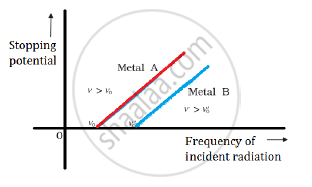Advertisements
Advertisements
प्रश्न
Define (i) stopping potential and (ii) threshold frequency, using Einstein’s equation and drawing necessary plot between relevant quantities.
उत्तर
Stopping potential: For a particular frequency of incident radiation, the minimum negative (retarding) potential V0 for which the photocurrent stops or becomes zero is called the cut-off or stopping potential.
Threshold frequency: The minimum frequency required for photoelectrons to be emitted from a metal surface is called the threshold frequency.
The graph between stopping potential and frequency of incident radiation is shown below:

APPEARS IN
संबंधित प्रश्न
When radiations of wavelength λ1 and λ2 are incident on certain photosensitive, such that E1 > E2 . Then Planck's constant 'h' is ......................... .
(C = Velocity of light).
The photoelectric threshold wavelength of a metal is 230 nm. Determine the maximum kinetic energy in joule and in eV of the ejects electron for the metal surface when it is exposed to a radiation of wavelength 180 nm.
[Planck’s constant : h = 6.63 * 10-34 Js, Velocity of light : C = 3 * 108 m/s.]
Write the basic features of photon picture of electromagnetic radiation on which Einstein’s photoelectric equation is based.
According to Einstein’s model minimum energy needed for the electron to escape from a metal surface having work function ϕ0, the electron is emitted with maximum kinetic energy, Kmax = ______.
Plot a labelled graph of |Vs| where Vs is stopping potential versus frequency f of the incident radiation. State how will you use this graph to determine the value of Planck's constant?
In an inelastic collision, which of the following does not remain conserved?
Who indirectly determined the mass of the electron by measuring the charge of the electrons?
Which of the following is/are true for cathode ray
The moment of a photon is given by
How does stopping potential in photoelectric emission vary if the intensity of the incident radiation increases?
